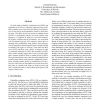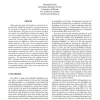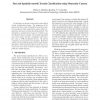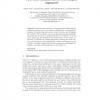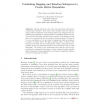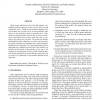CLEF
2010
Springer
13 years 5 months ago
2010
Springer
The goal of this work is to investigate the performance of classical methods for feature description and classification, and to identify the difficulties of the ImageCLEF 2010 moda...
ICMLA
2007
13 years 6 months ago
2007
For both single probability estimation trees (PETs) and ensembles of such trees, commonly employed class probability estimates correct the observed relative class frequencies in e...
ICMLA
2008
13 years 6 months ago
2008
Using decision trees that split on randomly selected attributes is one way to increase the diversity within an ensemble of decision trees. Another approach increases diversity by ...
ICMLA
2008
13 years 6 months ago
2008
When using the output of classifiers to calculate the expected utility of different alternatives in decision situations, the correctness of predicted class probabilities may be of...
ICPR
2010
IEEE
13 years 8 months ago
2010
IEEE
In this paper, we present a monocular camera based terrain classification scheme. The uniqueness of the proposed scheme is that it inherently incorporates spatial smoothness while...
ILP
2004
Springer
13 years 10 months ago
2004
Springer
Random forest induction is a bagging method that randomly samples the feature set at each node in a decision tree. In propositional learning, the method has been shown to work well...
IDA
2007
Springer
13 years 10 months ago
2007
Springer
Random forests are one of the best performing methods for constructing ensembles. They derive their strength from two aspects: using random subsamples of the training data (as in b...
IDEAS
2007
IEEE
13 years 10 months ago
2007
IEEE
Many recent applications deal with data streams, conceptually endless sequences of data records, often arriving at high flow rates. Standard data-mining techniques typically assu...
JCDL
2009
ACM
13 years 11 months ago
2009
ACM
Users of digital libraries usually want to know the exact author or authors of an article. But different authors may share the same names, either as full names or as initials and...
ICDM
2009
IEEE
13 years 11 months ago
2009
IEEE
Abstract—We introduce and validate Spatiotemporal Relational Random Forests, which are random forests created with spatiotemporal relational probability trees. We build on the do...

